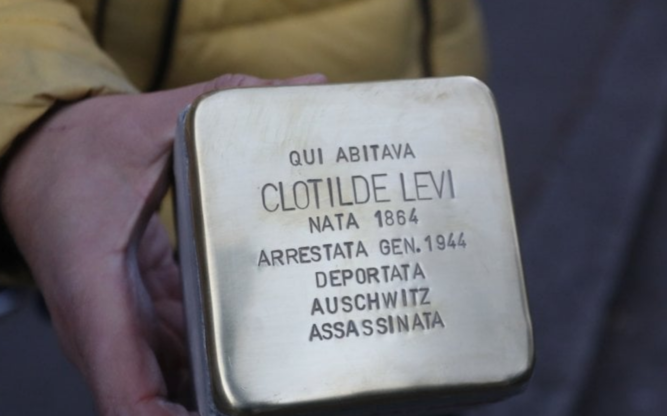‘Stumbling Stones’ Placed to Remember Florence’s Holocaust Victims
 Florence is commemorating the lost souls taken by the Nazis in Florence and sent to concentration camps in 1944, never to return, by commissioning approximately 50 stumbling stones (“pietre di inciampo” in Italian) for the sidewalks. A prologue to the Holocaust Remembrance Day was the placement of a number of square-shaped memorials on city streets throughout the month of January. These plaques, 10 x 10 cm (4 x 4 inches), are the same size as cobblestones, but their bronze surfaces are engraved with the first and last names of the victims, their dates of birth, capture, and death.
Florence is commemorating the lost souls taken by the Nazis in Florence and sent to concentration camps in 1944, never to return, by commissioning approximately 50 stumbling stones (“pietre di inciampo” in Italian) for the sidewalks. A prologue to the Holocaust Remembrance Day was the placement of a number of square-shaped memorials on city streets throughout the month of January. These plaques, 10 x 10 cm (4 x 4 inches), are the same size as cobblestones, but their bronze surfaces are engraved with the first and last names of the victims, their dates of birth, capture, and death.
These stones not only remember the Jewish lives that were taken so abruptly to German concentration camps never to return alive but also other casualties from Roma and Sinti communities, along with homosexuals, and political dissidents. The stumbling stones are located throughout the city in front of the homes of the departed; the “stolperstein” were originally created and named by the German artist, Gunter Demnig, who envisioned a unique way to pay tribute to those lost to the horrific genocide.
A number of stumbling stones will be unveiled on Thursday, January 23 and the public is invited to attend. On that day, ceremonies will take place in piazza d’Azeglio 12 (12:30 pm) in memory of Giuseppe Siebzehner and Amalia Koretz; via Bovio 1 (3 pm) to remember Giorgio Levi delle Trezze and Haya Poliakov Xenia; via Bovio 7 (3 pm) to commemorate Lucia Levi; piazza delle Cure 7 (4:45 pm) as a tribute to Aldo and Giulio Levi together with Adriana Castelli; and via Marsala 2 at Campo di Marte (4 pm) for Gallico family members Amelia, Augusto, Lucio, Sergio and Giulia Pacifici.
The first of the pavement plaques were inaugurated on January 9, including six stones at via del Gelsomino 29. One recalls the life of Rabbi Rodolfo Levi, who was captured by the Nazis on February 6, 1944. While meeting a friend, he was confronted by a Nazi and forced to tell where his family was. His wife Rina Procaccia and daughter Noemi, hidden by the Morandi family, were taken. Those captured in the apartment included Sinigaglia family members: Angelo, his wife in addition to Rina’s sister Amelia Procaccia and her 11-year-old daughter Alda. They all lost their lives at the Auschwitz and Mauthausen concentration camps that year.
The remaining 20+ stones will find their permanent home on January 27, Holocaust Remembrance Day. (tessa cervantes-roth)
